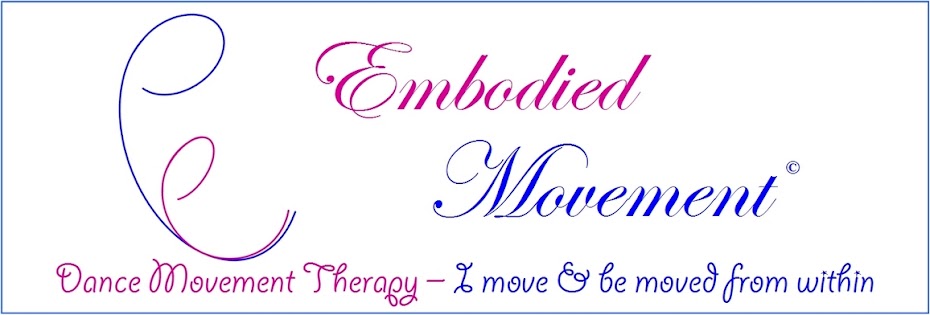 |
| Elizabeth, founder of Embodied Movement, drew this during her Creative Me Time on her programme, Movin' Tales. Copyright of Embodied Movement. |
What spurs me to develop my own programmes?
To move,
To be moved,
Being moved to move
By my & your own Tales.
~ Elizabeth Rutten-Ng
My work, for many years, has always revolved around children. Having gone through my own personal journey and transformation, overcoming many challenges as a little girl till my adulthood, I have reclaimed my inner child and security. I forge to provide programmes which can enable and empower parents, caregivers, educators and professional who care for children be they typical or with special needs. I care to want to make a difference in the world where the future belongs to the next generation who will inherit Mother Earth.
~~~~~~~~~~~~~~~~
The nature of the Movin’ Tales programme is developed over a period of time with themes, focusing on the social-psycho-emotional well-being of each child, learning English at the same time incidentally. An added value and benefit to a creative approach in the Movin’ Tales programme is that “a child’s ability to review and relearn in a playful manner important physical developmental stages that may have been missed or rushed through at an earlier age” (Tortora, 2005, Dancing Dialogue). It's also to revisit it and support them when there is a need through dance and movement. Dance movement therapy activities are added into the programme to integrate the physiological (physical/development), psychological, cognitive (mental), emotional, social as well as communicate in a holistic approach. It is important that the child is seen, heard, held, hugged (Tortora, Ways of Seeing) and acknowledged for each individual's self (developing self-esteem and confidence). Winnicott (1971) states, "When I am look, I am seen, so I exist."
The programme is catered to the age appropriateness, bearing in mind that each child's learning style is very different. Research has also shown the importance for children to move in their body and play during the developmental milestone and has a close link to learning. Children learn best and at optimal when they are feeling happy, safe, comfortable and through movements. Baby first language, in fact, is movements not words. Movin’ Tales is designed whereby the love for learning in this case English, is through creative fun ways and the purpose is to develop the intrinsic motivation in the child to learn. In the way how a new knowledge is being introduced is crucial. Children absorb like a sponge and are very sensitive during the growing stages. During the programme, other qualities are also considered such as building self-regulation and impulse control in various activities. It is important for children to have the ability and sense of control. Other areas I work on are resilience, autonomy, responsibility, compassion, empathy, boundary setting (a very important tool/skill as a youth and an adult). I had been a teacher in the mainstream and taught all ages and review often what works and does not work. Instead of focusing purely on the academic, I believe in the holistic approach in nurturing a child/student. The programme is crafted in the way of imparting and inculcating my love of language and creative arts into the heart of the young minds.
To see the overall developments, it takes time. I have my structured curriculum however I combine the freedom of expression in it, tapping on each child's creativity, gift, learning style and potential within them.
I facilitate my session oriented from the child's world and work on what they bring in. My training in movement analysis as a therapist and ways of seeing practitioner, specialised in developmental movements allow me to support the children in the programme other than therapy. It does take time and it is also a journey for the child as well as the adult to discover themselves and their needs through exploration. The process of learning about the world of things, including their various properties, is a “time-consuming and intense process that cannot be hurried.” (Elkind, 2001)
A child in Singapore has followed through my programme per semester, from parent-child to children; parents have reported back that they see the growth in the child (neurotypical). (Testimony is in my blog.). A baby takes 9 months to be ready to meet the world. My programmes take time to see the end results.
Lots of research are indicating when a child is being hurried, the consequence later in life as a youth and adulthood can be detrimental. I have worked with children over the 20 years, adults as well, and have been studying and researching in this area. Personally, I have my great concerns and worries over the children of the future generation at the rate they are going. That spurs me to create holistic programmes and a platform both in Netherlands and Asia where I can provide education and the support for parents, educators and professionals, and of course, children.
I'm no longer afraid to take the stand and move the mountain step by step to create a change in the world I hope to leave behind.
References:
Elkind, D. (2001). 3rd Edition. The Hurried Child. Cambridge: De Capo Press Book.
Tortora, S. (2005). Dancing Dialogue. Baltimore: Paul H. Brookes Publishing Co.
Tortora, S. Ways of Seeing. http://www.suzitortora.org/waysofseeing.html
Winnicott, D. W. (1971). Playing and Reality. London: Routledge
* Currently, Movin' Tales is being offered in Netherlands. Drop by for a trial class on 28th February. Register at Embodied Movement website.

